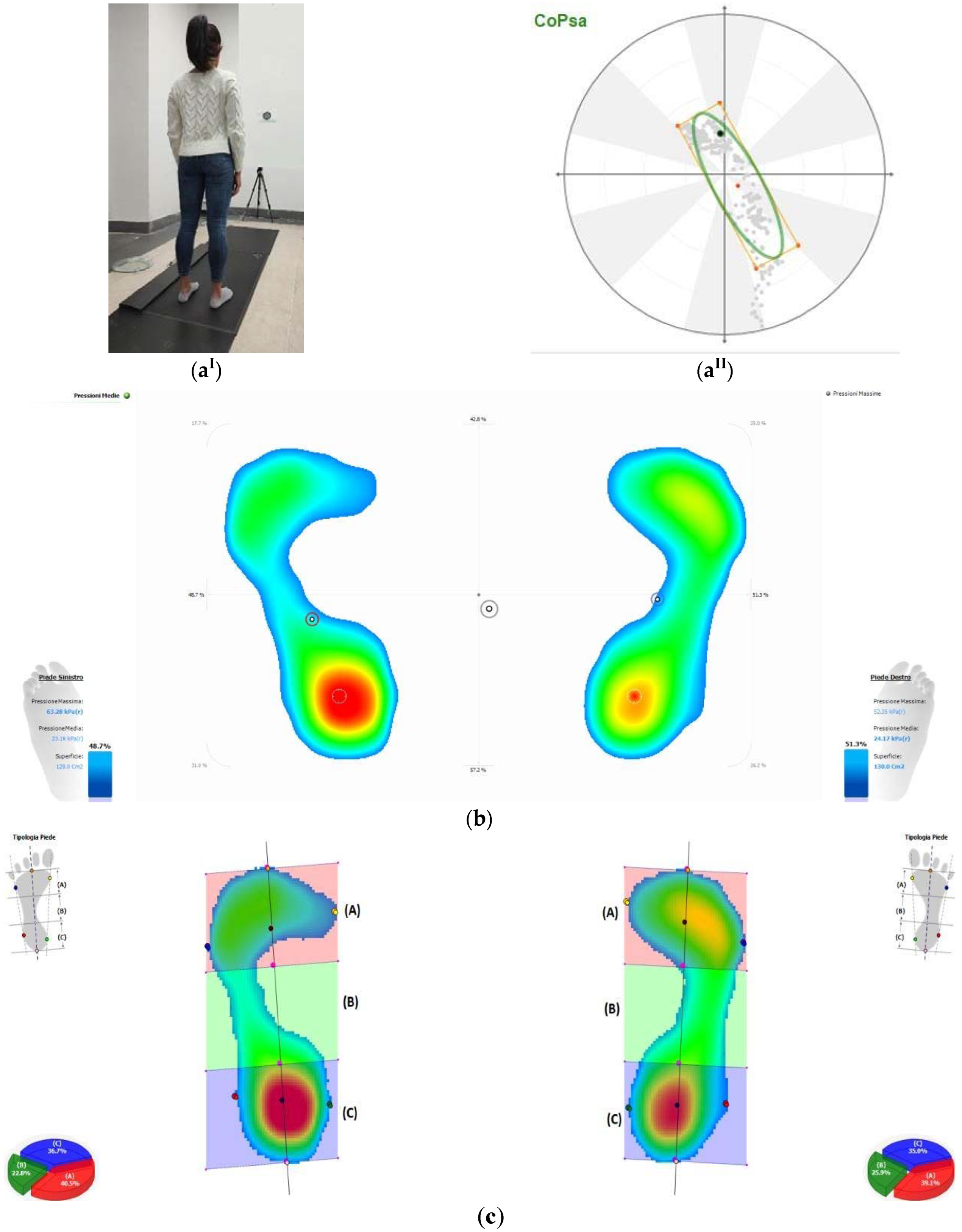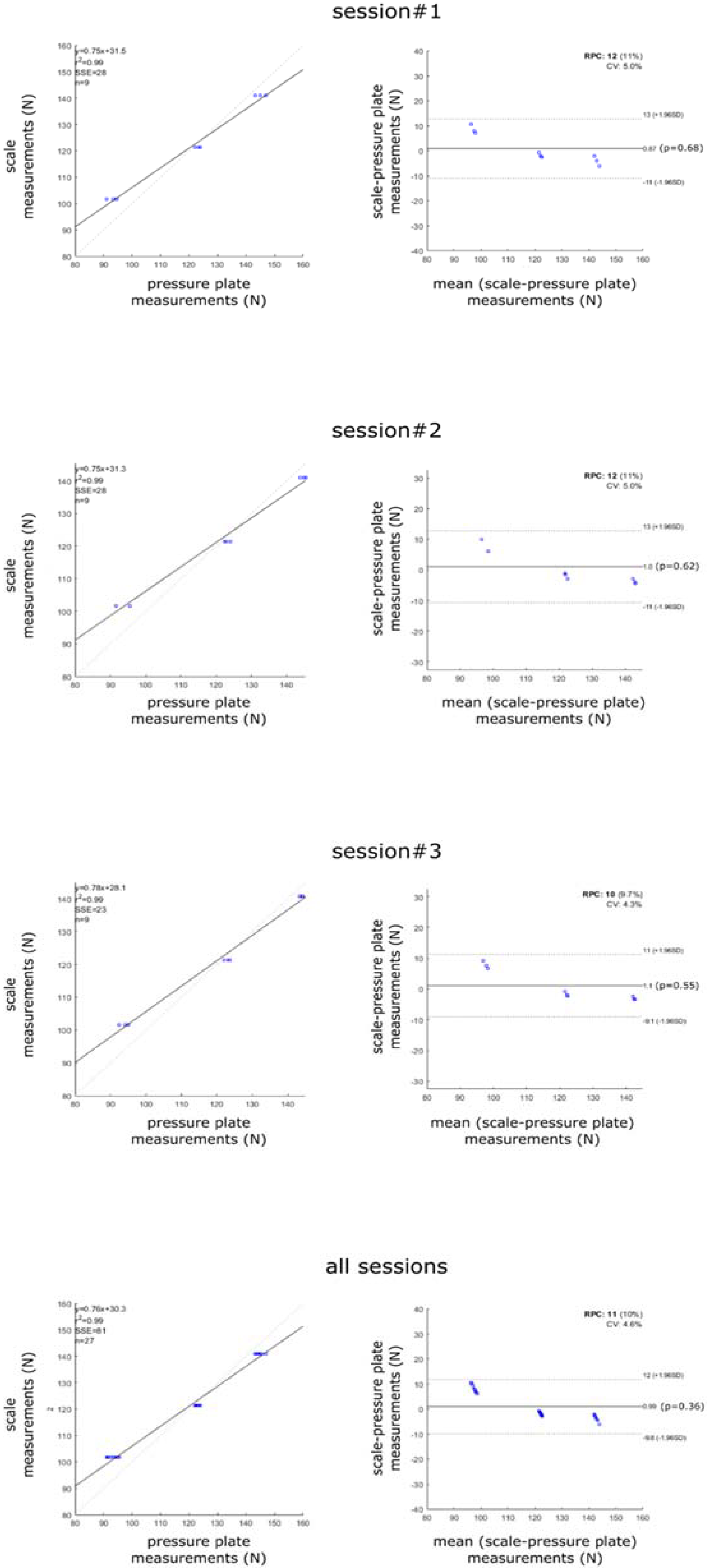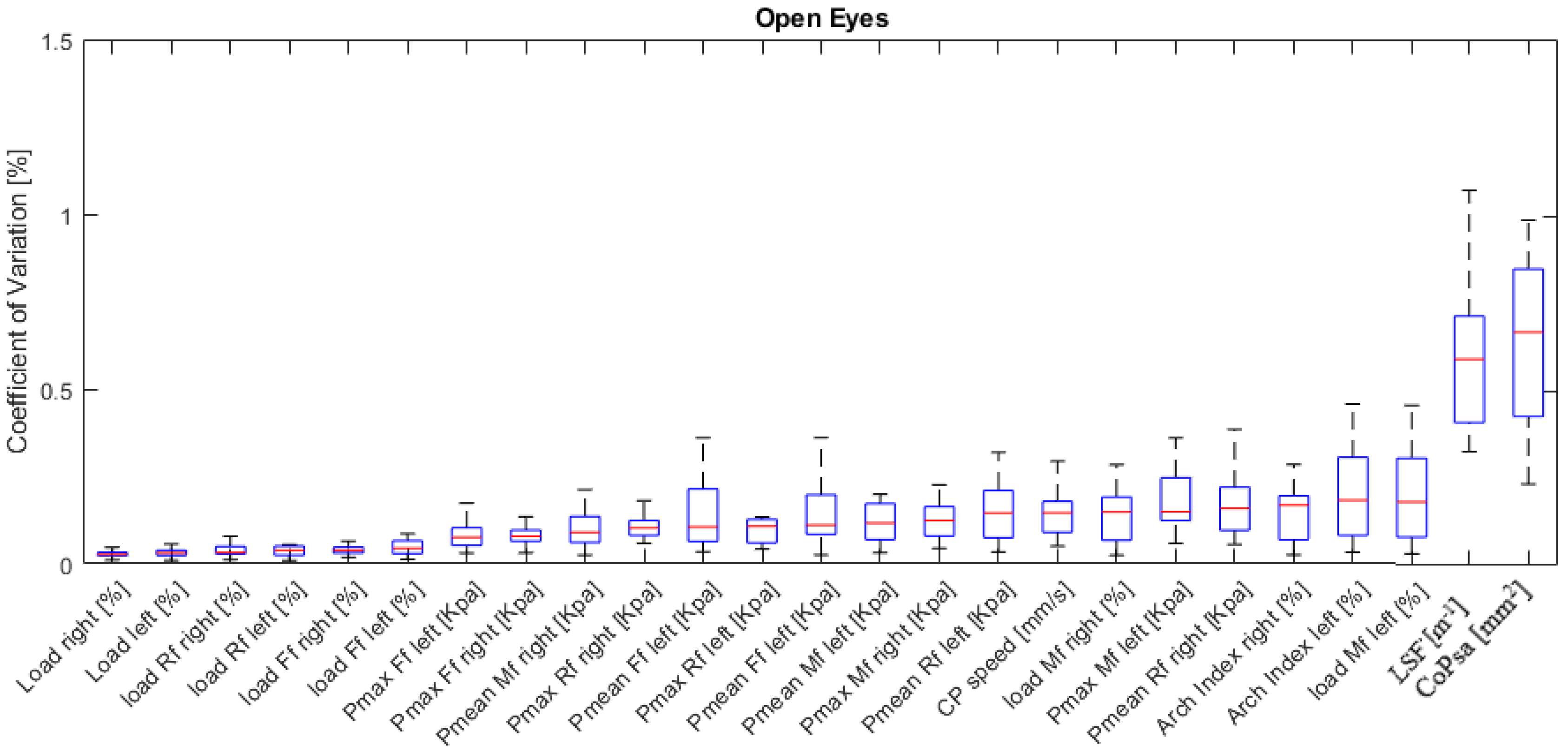Variability of Postural Stability and Plantar Pressure Parameters in Healthy Subjects Evaluated by a Novel Pressure Plate
Abstract
:1. Introduction
2. Method and Materials
3. Results
3.1. Repeatability and Accuracy of Pressure Plate Static Measurements
3.2. Intra-Subject Variability Test for Baropodometric and Stabilometric Parameters
3.3. Inter-Session Variability Test (Morning vs. Afternoon)
3.4. Normative Stabilometric and Baropodometric Parameters
4. Discussion
5. Conclusions
Author Contributions
Funding
Institutional Review Board Statement
Informed Consent Statement
Data Availability Statement
Acknowledgments
Conflicts of Interest
References
- Ivanenko, Y.; Gurfinkel, V.S. Human Postural Control. Front. Neurosci. 2018, 12, 171. [Google Scholar] [CrossRef] [PubMed]
- Takakusaki, K. Functional Neuroanatomy for Posture and Gait Control. J. Mov. Disord. 2017, 10, 1–17. [Google Scholar] [CrossRef] [PubMed]
- Moffa, S.; Perna, A. Effects of Hoverboard on Balance in Young Soccer Athletes. J. Funct. Morphol. Kinesiol. 2020, 5, 60. [Google Scholar] [CrossRef] [PubMed]
- Gagey, P.M.; Martinerie, J.; Pezard, L.; Benaim, C. Static balance is controlled by a non-linear dynamic system. In Annales D’oto-Laryngologie et de Chirurgie Cervico Faciale; Bulletin de la Societe D’oto-laryngologie des Hopitaux de Paris: Paris, France, 1998; Volume 115, pp. 161–168. [Google Scholar]
- Lakie, M.; Caplan, N. Human balancing of an inverted pendulum with a compliant linkage: Neural control by anticipatory inter-mittent bias. J. Physiol. 2003, 551 Pt 1, 357–370. [Google Scholar] [CrossRef]
- Buldt, A.K.; Forghany, S.; Landorf, K.B.; Murley, G.S.; Levinger, P.; Menz, H.B. Centre of pressure characteristics in normal, planus and cavus feet. J. Foot Ankle Res. 2018, 11, 3. [Google Scholar] [CrossRef] [Green Version]
- Woollacott, M.; Shumway-Cook, A. Attention and the control of posture and gait: A review of an emerging area of research. Gait Posture 2002, 16, 1–14. [Google Scholar] [CrossRef]
- Barozzi, S.; Di Berardino, F. A comparison between oculomotor rehabilitation and vestibular electrical stimulation in unilateral peripheral vestibular deficit. Int. Tinnitus J. 2006, 12, 45–49. [Google Scholar] [PubMed]
- Dingding Lin, A.; Hyang Seol, A. Reliability of COP-based postural sway measures and age-related differences. Gait Posture 2008, 28, 337–342. [Google Scholar] [CrossRef]
- Pimentel, R.J.L. A review of the utilization of baropodometry in postural assessment. J. Bodyw. Mov. Ther. 2014, 18, 215–219. [Google Scholar] [CrossRef]
- Baumfeld, D.; Baumfeld, T. Reliability of Baropodometry on the Evaluation of Plantar Load Distribution: A Transversal Study. BioMed Res. Int. 2017, 2017, 5925137. [Google Scholar] [CrossRef] [Green Version]
- Giacomozzi, C. Hardware performance assessment recommendations and tools for baropodometric sensor systems. Ann Ist. Super. Della Sanità 2010, 46, 158–167. [Google Scholar] [CrossRef]
- Giacomozzi, C. Appropriateness of plantar pressure measurement devices: A comparative technical assessment. Gait Posture 2010, 32, 141–144. [Google Scholar] [CrossRef] [PubMed]
- Hébert-Losier, K.; Murray, L. Reliability of centre of pressure, plantar pressure, and plantar-flexion isometric strength measures: A systematic review. Gait Posture 2020, 75, 46–62. [Google Scholar] [CrossRef] [PubMed]
- Gagey, P.M.; Weber, B. Study of intra-subject random variations of stabilometric parameters. Med. Biol. Eng. Comput. 2010, 48, 833–835. [Google Scholar] [CrossRef] [PubMed]
- Samson, M.; Crowe, A. Intra-subject inconsistencies in quantitative assessment of body sway. Gait Posture 1996, 4, 252–257. [Google Scholar] [CrossRef]
- Russo, L.; D’Eramo, U. Day-time effect on postural stability in young sportsmen. Muscles Ligaments Tendons J. 2015, 5, 38–42. [Google Scholar] [CrossRef] [PubMed]
- Alves, R.; Porfirio Borel, W. Test-retest reliability of baropodometry in young asyntomatic individuals during semi static and dynamic analysis. Fisioter. Mov. 2018, 31, e003114. [Google Scholar] [CrossRef]
- Baldini, A.; Nota, A. Intersession reliability of a posturo-stabilometric test, using a force platform. J. Electromyogr. Kinesiol. 2013, 23, 1474–1479. [Google Scholar] [CrossRef] [Green Version]
- Izquierdo-Renaua, M.; Pérez-Sorianob, P. Intra and intersession repeatability and reliability of the S-Plate1 pressure platform. Gait Posture 2017, 52, 224–226. [Google Scholar] [CrossRef]
- Putti, A.B.; Arnold, G.P. Normal pressure values and repeatability of the Emed ST4 system. Gait Posture 2008, 27, 501–505. [Google Scholar] [CrossRef]
- Geurts, A.C.H.; Nienhuis, B. Intrasubject Variability of Selected Force-Platform Parameters in the Quantification of Postural Control. Arch. Phys. Med. Rehabil. 1993, 74, 1144–1150. [Google Scholar] [PubMed]
- Ohlendorf, D.; Doerry, C. Standard reference values of the postural control in healthy young female adults in Germany: An observational study. BMJ Open 2019, 9, e026833. [Google Scholar] [CrossRef] [PubMed] [Green Version]
- Ohlendorf, D.; Pflaum, J. Standard reference values of the postural control in healthy female adults aged between 31 and 40 years in Germany: An observational study. J. Physiol. Anthropol. 2020, 39, 27. [Google Scholar] [CrossRef] [PubMed]
- Scoppa, F.; Gallamini, M. Clinical stabilometry standardization: Feet position in the static stabilometric assessment of postural stability. Acta Med. Mediterr. 2017, 33, 707. [Google Scholar] [CrossRef]
- R Core Team. R: A Language and Environment for Statistical Computing; R Foundation for Statistical Computing: Vienna, Austria, 2018; Available online: https://www.R-project.org (accessed on 12 December 2021).
- Cavanagh, P.R.; Rodgers, M.M. The arch index: A useful measure from footprints. J. Biomech. 1987, 20, 547–551. [Google Scholar] [CrossRef]
- Marencakova, J.; Maly, T.; Sugimoto, D.; Gryc, T.; Zahalka, F. Foot typology, body weight distribution, and postural stability of adolescent elite soccer players: A 3-year longitudinal study. PLoS ONE 2018, 13, e0204578. [Google Scholar] [CrossRef]
- Ohlendorf, D.; Kerth, K.; Osiander, W.; Holzgreve, F.; Fraeulin, L.; Ackermann, H.; Groneberg, D.A. Standard reference values of weight and maximum pressure distribution in healthy adults aged 18–65 years in Germany. J. Physiol. Anthropol. 2020, 39, 39. [Google Scholar] [CrossRef]
- De Blasiis, P.; Fullin, A. Long-term effects of asymmetrical posture in boxing assessed by baropodometry. J. Sports Med. Phys. Fit. 2021, 62, 350–355. [Google Scholar] [CrossRef]
- Baione, V.; Ferrazzano, G. Attention-Demanding Cognitive Tasks Worsen Postural Control in Patients With Cervical Dystonia: A Case-Control Study. Front. Neurol. 2021, 12, 666438. [Google Scholar] [CrossRef]
- Prieto, T.E.; Myklebust, J.B. Measures of postural steadiness: Differences between healthy young and elderly adults. IEEE Trans. Biomed. Eng. 1996, 43, 956–966. [Google Scholar] [CrossRef]



| Stabilometric and Plantar Pressure Parameters | Pearson R2 |
|---|---|
| Load left (%) | NS |
| Load right (%) | NS |
| CoPsa (mm2) | 0.37 |
| CP speed (mm/s) | NS |
| Load Rf left (%) | 0.85 |
| Load Rf right (%) | 0.86 |
| Load Mf left (%) | 0.91 |
| Load Mf right (%) | 0.89 |
| Load Ff left (%) | 0.76 |
| Load Ff right (%) | 0.87 |
| Arch Index right (%) | 0.88 |
| Arch Index left (%) | 0.91 |
| LSF (mm−1) | NS |
| Pmean Ff left (Kpa) | 0.55 |
| Pmean Mf left (Kpa) | 0.46 |
| Pmean Rf left (Kpa) | 0.66 |
| Pmean Ff left (Kpa) | 0.51 |
| Pmean Mf right (Kpa) | 0.23 |
| Pmean Rf right (Kpa) | 0.67 |
| Pmax Ff left (Kpa) | 0.71 |
| Pmax Mf left (Kpa) | NS |
| Pmax Rf left (Kpa) | 0.62 |
| Pmax Ff right (Kpa) | 0.62 |
| Pmax Mf right (Kpa) | NS |
| Pmax Rf right (Kpa) | 0.57 |
| Stabilometric and Plantar Pressure Parameters | Percentiles | ||
|---|---|---|---|
| Median | 25% | 75% | |
| Load left (%) | 46.5 | 45.7 | 48.7 |
| Load right (%) | 53.5 | 51.3 | 54.4 |
| CoPsa (mm2) | 28.8 | 23.5 | 41.7 |
| CP speed (mm/s) | 3.4 | 3.1 | 3.9 |
| Load Rf left (%) | 41.2 | 36.5 | 44.9 |
| Load Rf right (%) | 36.9 | 33.9 | 42.0 |
| Load Mf left (%) | 14.1 | 8.6 | 25.1 |
| Load Mf right (%) | 20.8 | 12.9 | 24.9 |
| Load Ff left (%) | 43.9 | 41.0 | 45.1 |
| Load Ff right (%) | 43.1 | 40.9 | 43.9 |
| Arch Index right (%) | 20.6 | 12.9 | 24.9 |
| Arch Index left (%) | 14.1 | 8.6 | 25.3 |
| LSF (mm−1) | 4.7 | 3.8 | 7.1 |
| Pmean Ff left (Kpa) | 59.1 | 53.2 | 67.9 |
| Pmean Mf left (Kpa) | 16.4 | 15.0 | 18.8 |
| Pmean Rf left (Kpa) | 27.4 | 23.8 | 35.6 |
| Pmean Ff left (Kpa) | 69.9 | 60.3 | 83.9 |
| Pmean Mf right (Kpa) | 18.3 | 17.0 | 20.0 |
| Pmean Rf right (Kpa) | 23.2 | 18.7 | 31.0 |
| Pmax Ff left (Kpa) | 44.5 | 41.8 | 49.3 |
| Pmax Mf left (Kpa) | 32.1 | 27.3 | 38.8 |
| Pmax Rf left (Kpa) | 67.3 | 59.5 | 80.5 |
| Pmax Ff right (Kpa) | 49.6 | 48.3 | 55.0 |
| Pmax Mf right (Kpa) | 35.9 | 33.3 | 38.3 |
| Pmax Rf right (Kpa) | 63.3 | 55.8 | 71.0 |
Publisher’s Note: MDPI stays neutral with regard to jurisdictional claims in published maps and institutional affiliations. |
© 2022 by the authors. Licensee MDPI, Basel, Switzerland. This article is an open access article distributed under the terms and conditions of the Creative Commons Attribution (CC BY) license (https://creativecommons.org/licenses/by/4.0/).
Share and Cite
Fullin, A.; Caravaggi, P.; Picerno, P.; Mosca, M.; Caravelli, S.; De Luca, A.; Lucariello, A.; De Blasiis, P. Variability of Postural Stability and Plantar Pressure Parameters in Healthy Subjects Evaluated by a Novel Pressure Plate. Int. J. Environ. Res. Public Health 2022, 19, 2913. https://doi.org/10.3390/ijerph19052913
Fullin A, Caravaggi P, Picerno P, Mosca M, Caravelli S, De Luca A, Lucariello A, De Blasiis P. Variability of Postural Stability and Plantar Pressure Parameters in Healthy Subjects Evaluated by a Novel Pressure Plate. International Journal of Environmental Research and Public Health. 2022; 19(5):2913. https://doi.org/10.3390/ijerph19052913
Chicago/Turabian StyleFullin, Allegra, Paolo Caravaggi, Pietro Picerno, Massimiliano Mosca, Silvio Caravelli, Antonio De Luca, Angela Lucariello, and Paolo De Blasiis. 2022. "Variability of Postural Stability and Plantar Pressure Parameters in Healthy Subjects Evaluated by a Novel Pressure Plate" International Journal of Environmental Research and Public Health 19, no. 5: 2913. https://doi.org/10.3390/ijerph19052913
APA StyleFullin, A., Caravaggi, P., Picerno, P., Mosca, M., Caravelli, S., De Luca, A., Lucariello, A., & De Blasiis, P. (2022). Variability of Postural Stability and Plantar Pressure Parameters in Healthy Subjects Evaluated by a Novel Pressure Plate. International Journal of Environmental Research and Public Health, 19(5), 2913. https://doi.org/10.3390/ijerph19052913











